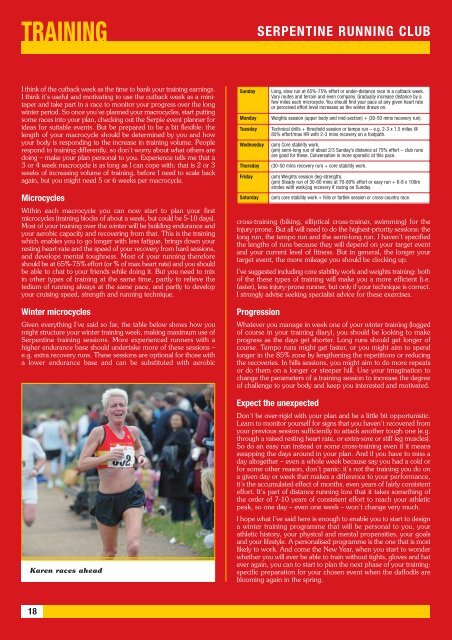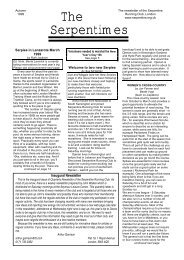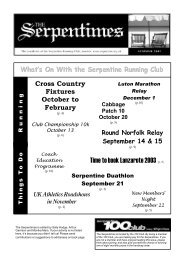AUTUMN 2007 - Serpentine
AUTUMN 2007 - Serpentine
AUTUMN 2007 - Serpentine
Create successful ePaper yourself
Turn your PDF publications into a flip-book with our unique Google optimized e-Paper software.
TRAINING<br />
SERPENTINE RUNNING CLUB<br />
I think of the cutback week as the time to bank your training earnings.<br />
I think it’s useful and motivating to use the cutback week as a minitaper<br />
and take part in a race to monitor your progress over the long<br />
winter period. So once you’ve planned your macrocycles, start putting<br />
some races into your plan, checking out the Serpie event planner for<br />
ideas for suitable events. But be prepared to be a bit flexible: the<br />
length of your macrocycle should be determined by you and how<br />
your body is responding to the increase in training volume. People<br />
respond to training differently, so don’t worry about what others are<br />
doing – make your plan personal to you. Experience tells me that a<br />
3 or 4 week macrocycle is as long as I can cope with: that is 2 or 3<br />
weeks of increasing volume of training, before I need to scale back<br />
again, but you might need 5 or 6 weeks per macrocycle.<br />
Microcycles<br />
Within each macrocycle you can now start to plan your first<br />
microcycles (training blocks of about a week, but could be 5-10 days).<br />
Most of your training over the winter will be building endurance and<br />
your aerobic capacity and recovering from that. This is the training<br />
which enables you to go longer with less fatigue, brings down your<br />
resting heart-rate and the speed of your recovery from hard sessions,<br />
and develops mental toughness. Most of your running therefore<br />
should be at 65%-75% effort (or % of max heart rate) and you should<br />
be able to chat to your friends while doing it. But you need to mix<br />
in other types of training at the same time, partly to relieve the<br />
tedium of running always at the same pace, and partly to develop<br />
your cruising speed, strength and running technique.<br />
Winter microcycles<br />
Given everything I’ve said so far, the table below shows how you<br />
might structure your winter training week, making maximum use of<br />
<strong>Serpentine</strong> training sessions. More experienced runners with a<br />
higher endurance base should undertake more of these sessions –<br />
e.g. extra recovery runs. These sessions are optional for those with<br />
a lower endurance base and can be substituted with aerobic<br />
Karen races ahead<br />
Sunday<br />
Monday<br />
Tuesday<br />
Wednesday<br />
Thursday<br />
Friday<br />
Saturday<br />
cross-training (biking, elliptical cross-trainer, swimming) for the<br />
injury-prone. But all will need to do the highest-priority sessions: the<br />
long run, the tempo run and the semi-long run. I haven’t specified<br />
the lengths of runs because they will depend on your target event<br />
and your current level of fitness. But in general, the longer your<br />
target event, the more mileage you should be clocking up.<br />
I’ve suggested including core stability work and weights training: both<br />
of the these types of training will make you a more efficient (i.e.<br />
faster), less injury-prone runner, but only if your technique is correct.<br />
I strongly advise seeking specialist advice for these exercises.<br />
Progression<br />
Long, slow run at 65%-75% effort or under-distance race in a cutback week.<br />
Vary routes and terrain and even company. Gradually increase distance by a<br />
few miles each microcycle. You should find your pace at any given heart rate<br />
or perceived effort level increases as the winter draws on.<br />
Weights session (upper body and mid-section) + (30-50 mins recovery run).<br />
Technical drills + threshold session or tempo run – e.g. 2-3 x 1.5 miles @<br />
85% effort/max HR with 2-3 mins recovery on a footpath.<br />
(am) Core stability work.<br />
(pm) semi-long run of about 2/3 Sunday’s distance at 75% effort – club runs<br />
are good for these. Conversation is more sporadic at this pace.<br />
(30-50 mins recovery run) + core stability work.<br />
(am) Weights session (leg-strength).<br />
(pm) Steady run of 30-60 mins at 70-80% effort or easy run + 6-8 x 100m<br />
strides with walk/jog recovery if racing on Sunday.<br />
(am) core stability work + hills or fartlek session or cross-country race.<br />
Whatever you manage in week one of your winter training (logged<br />
of course in your training diary), you should be looking to make<br />
progress as the days get shorter. Long runs should get longer of<br />
course. Tempo runs might get faster, or you might aim to spend<br />
longer in the 85% zone by lengthening the repetitions or reducing<br />
the recoveries. In hills sessions, you might aim to do more repeats<br />
or do them on a longer or steeper hill. Use your imagination to<br />
change the parameters of a training session to increase the degree<br />
of challenge to your body and keep you interested and motivated.<br />
Expect the unexpected<br />
Don’t be over-rigid with your plan and be a little bit opportunistic.<br />
Learn to monitor yourself for signs that you haven’t recovered from<br />
your previous session sufficiently to attack another tough one (e.g.<br />
through a raised resting heart rate, or extra-sore or stiff leg muscles).<br />
So do an easy run instead or some cross-training even if it means<br />
swapping the days around in your plan. And if you have to miss a<br />
day altogether – even a whole week because say you had a cold or<br />
for some other reason, don’t panic: it’s not the training you do on<br />
a given day or week that makes a difference to your performance,<br />
it’s the accumulated effect of months, even years of fairly consistent<br />
effort. It’s part of distance running lore that it takes something of<br />
the order of 7-10 years of consistent effort to reach your athletic<br />
peak, so one day – even one week – won’t change very much.<br />
I hope what I’ve said here is enough to enable you to start to design<br />
a winter training programme that will be personal to you, your<br />
athletic history, your physical and mental propensities, your goals<br />
and your lifestyle. A personalised programme is the one that is most<br />
likely to work. And come the New Year, when you start to wonder<br />
whether you will ever be able to train without tights, gloves and hat<br />
ever again, you can to start to plan the next phase of your training:<br />
specific preparation for your chosen event when the daffodils are<br />
blooming again in the spring.<br />
18




